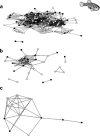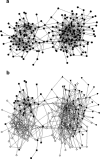Social network theory in the behavioural sciences: potential applications
- PMID: 32214613
- PMCID: PMC7079911
- DOI: 10.1007/s00265-007-0445-8
Social network theory in the behavioural sciences: potential applications
Abstract
Social network theory has made major contributions to our understanding of human social organisation but has found relatively little application in the field of animal behaviour. In this review, we identify several broad research areas where the networks approach could greatly enhance our understanding of social patterns and processes in animals. The network theory provides a quantitative framework that can be used to characterise social structure both at the level of the individual and the population. These novel quantitative variables may provide a new tool in addressing key questions in behavioural ecology particularly in relation to the evolution of social organisation and the impact of social structure on evolutionary processes. For example, network measures could be used to compare social networks of different species or populations making full use of the comparative approach. However, the networks approach can in principle go beyond identifying structural patterns and also can help with the understanding of processes within animal populations such as disease transmission and information transfer. Finally, understanding the pattern of interactions in the network (i.e. who is connected to whom) can also shed some light on the evolution of behavioural strategies.
Keywords: Cooperation; Disease transmission; Information transfer; Mate choice; Social networks; Social organisation.
© Springer-Verlag 2007.
Figures






References
-
- Berman CM, Rasmussen KLR, Suomi SJ. Group size, infant development and social networks in free-ranging rhesus monkeys. Anim Behav. 1997;53:405–421. doi: 10.1006/anbe.1996.0321. - DOI
-
- Bezanson M, Garber PA, Rutherford J, Cleveland A. Patterns of subgrouping, social affiliation and social networks in Nicaraguan mantled howler monkeys (Alouatta palliata) Am J Phys Anthropol Suppl. 2002;34:44.
-
- Borgatti SP, Everett MG, Freeman LC. UCINET for Windows, version 6: software for social network analysis. Harvard, MA: Analytic Technologies; 2002.
Publication types
LinkOut - more resources
Full Text Sources
